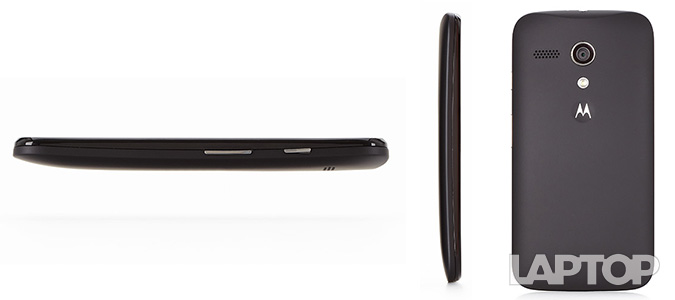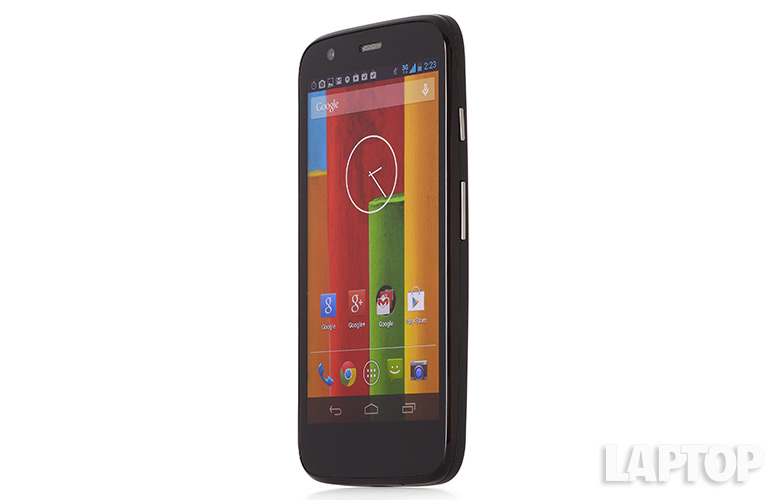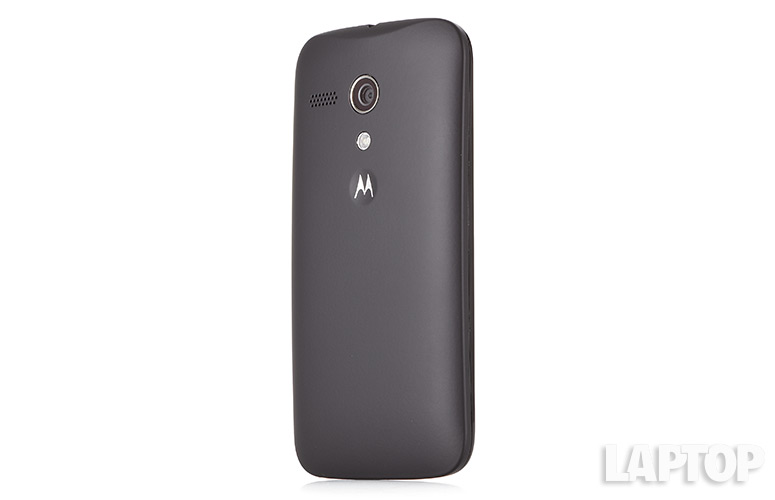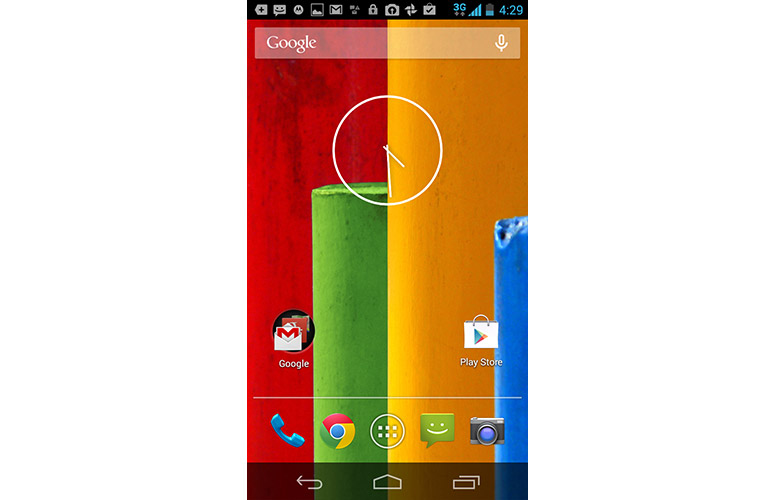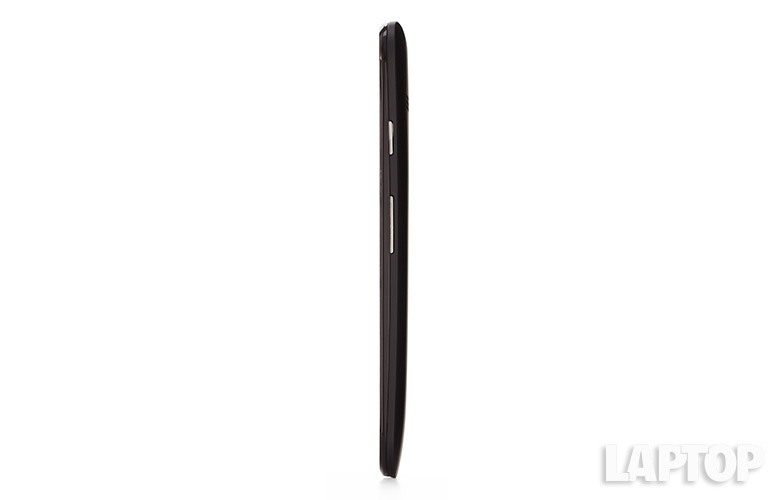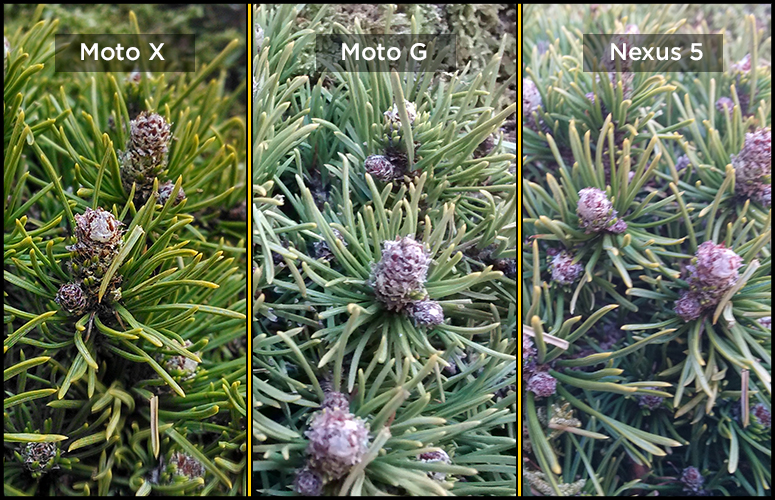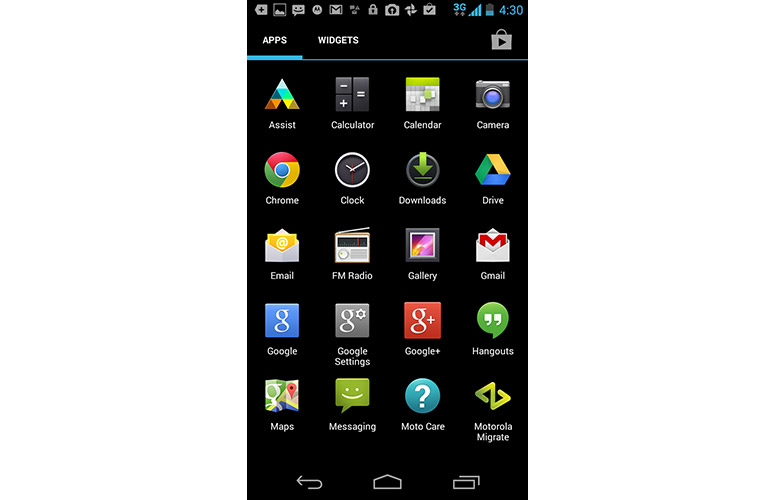Laptop Mag Verdict
With its smooth performance, attractive design and low, $199 price, the Moto G is one of the better unlocked-phone deals.
Pros
- +
Attractive design
- +
Crisp HD display
- +
Good performance for price
- +
Clean Android build
- +
Affordable
Cons
- -
No 4G LTE support
- -
Lacks touchless voice controls
- -
Lower resolution 5-MP camera
Why you can trust Laptop Mag
Motorola is out to prove that you don't need to drop a lot of cash on a contract-free smartphone to guarantee an enjoyable experience. The $199 Moto G is a budget smartphone that combines a fun, customizable design with a fairly pure Android experience. Equipped with quad-core processor, a 4.5-inch 720p display and an attractive design, is the Moto G the best unlocked-phone you can get for the price?
Design
The Moto G sports a sleek, simplistic design that's become the hallmark of Google and Motorola's handsets. On the front, you'll find an edge-to-edge glass design with chunky bezels along the top and bottom. However, the side bezels are so slim they're barely present alongside the handset's 720p display.
Our favorite physical characteristic of the Moto G is its soft-touch back, which features the same ergonomically round shape as the phone's more premium sibling, the Moto X. You won't be able to customize the device with Motorola's Moto Maker, but the company has provided a host of back shells ($14.99 each) in vibrant colors. Options include Chalk, Violet, Royal Blue, Turquoise, Lemon Lime and Cherry. The Flip Covers, which feature a magnetic display cover, are available in the same shades as the rear shells.
MORE: Best Mobile Products of the Year
Measuring 5.1 x 2.6 x 0.2-0.4 inches, the Moto G is nearly the exact same size as the Moto X and sports nearly the same measurements as the 5.04 x 2.59 x 0.4 inch, $199.99, contract-free LG Optimus F6 (Metro PCS). The more expensive Nexus 5 is slightly longer and thicker than all three phones, at 5.4 x 2.8 x 0.3 inches. And at 5.05 ounces, the Moto G is also slightly heavier than the 4.6-ounce Optimus F6 and Nexus 5, as well as the 4.8-ounce Moto X.
Display
Sign up to receive The Snapshot, a free special dispatch from Laptop Mag, in your inbox.
Click to EnlargeThe Moto G's 1280 x 720, 4.5-inch display is sharp and vibrant enough for viewing high-res photos, watching movies and playing games. When showing a trailer for "The Secret Life of Walter Mitty," outdoor scenes with lush green landscapes looked particularly bold. In a still-shot overlooking mountainous terrain, we could see every groove and detail in the rocky landscape. Close-up shots of Ben Stiller's face also looked especially crisp, and we were impressed with the handset's viewing angles. After placing the Moto G about one foot to our left, we could still easily view the trailer with minimal glare.
In side-by-side tests, the Nexus 5's 4.95-inch, 1920 x 1080 LCD display offered the most detail, but the Moto X's 4.7-inch, 720p AMOLED screen undoubtedly rendered the brightest and boldest colors. This is likely due to the Moto X's RGB subpixel structure technology, which means each pixel gets its own blue, green and red subpixels.
When compared against the Moto X and Nexus 5, the Moto G's display also sports a noticeable purple tint. This was most apparent in images with white and blue colors, such as the snow-covered scene in "The Secret Life of Walter Mitty" trailer. The snow appeared as an entirely different color on the Moto G's display compared to its competitors.
The phone's display isn't as bright as your average smartphone's screen. Hitting 363 lux on our light meter, the handset fell below the 400-lux smartphone category average and is dimmer than the LG Optimus F6's 4.5-inch, 960 x 540, 401-lux display. The pricier Nexus 5 and Moto X also boast brighter displays at 460 lux and 472 lux, respectively.
MORE: 6 Hottest Smartphones Right Now
Audio
Click to EnlargeThe Moto G's rear-mounted speakers produced loud but somewhat shallow audio. When blasting "Reptilia" by The Strokes and "Seven Nation Army" by The White Stripes -- two songs with very prominent bass riffs -- the bass track lacked oomph.
Still, the Moto G sounded much clearer and louder than the Nexus 5. The same songs played through the Nexus 5's front-facing speakers sounded muffled, as if a pillow were being held over the phone, and it wasn't nearly as loud. The Moto X sounded nearly identical to the Moto G as it pumped sound at about the same volume with just as much clarity.
The Moto G emitted sound at 83 decibels during the LAPTOP Audio test, which is louder than your average smartphone, the Nexus 5 and the Moto X (all register 81 decibels). The LG Optimus F6 pumped out sound at a lower 78 decibels.
Interface
Click to EnlargeThe Moto G offers one of the cleanest Android experiences you can find on a non-Nexus device. From its lock screen to the app drawer, we couldn't find many differences between the stock OS and Motorola's ever-so-slightly skinned version of Android 4.3 Jelly Bean.
After unlocking the device, we were greeted with the Moto G's main home screen, which comes with the Google Now search bar, a time widget and shortcuts to a few Google apps by default. Dragging down from the top of the display (with one finger) launches the notification drawer, which displays app updates, missed calls and other alerts. Using two fingers to drag down from the top provides shortcuts to settings such as display brightness, Wi-Fi, the battery indicator, Bluetooth and Airplane Mode, among others.
While we love the simplistic look and feel of stock Android, other custom skins, such as Samsung's TouchWiz and LG's overlays, include more-robust quick-setting options. Still, stock Android fans will appreciate the Moto G's stripped down interface.
MORE: 12 Worst Android Annoyances and How to Fix Them
Performance
Click to EnlargeThe Moto G's quad-core 1.2-GHz Qualcomm MSM8x26 A7 CPU with 1GB of RAM packs plenty of power for daily use, even though it trails most flagship devices. We played "Super Monsters Ate My Condo" with eight other apps open, and didn't experience any hiccups. With just four other apps open, the camera launched in a quick 2.01 seconds.
The Moto G held its own in some synthetic benchmarks, as well, scoring a very good 8,251 in Quadrant, which tests the CPU, I/O and 3D graphics performance. This is higher than the 7,546 smartphone-category average and is almost twice as high as the LG Optimus F6's score (4,957), which uses a 1.2-GHz dual-core Qualcomm MSM8930 processor with 1GB of RAM.
The G also beat the more-premium Nexus 5 (7,696), which runs a 2.26-GHz Qualcomm Snapdragon 800 CPU with 2GB of RAM. However, the Moto X's 1.7-GHz dual core Qualcomm Snapdragon S4 with 2GB of RAM scored the highest (9,054).
The Moto G almost beat the 1,594 smartphone-category average during the Geekbench 3 test, but fell short at 1,156. It blew away the LG Optimus G6's score of 738, but both the Moto X (1,256) and Nexus 5 (2,689) scored higher.
The device took 12 minutes and 3 seconds to transcode a 204MB video from 1080p to 480p using Vidtrim, which is longer than the 8:17 smartphone category average. The Moto G's time did beat LG's offering (14:21), but wasn't quite as fast as the Moto X (6:41) or the Nexus 5 (7:51).
The Moto G's 450MHz Adreno 305 GPU didn't fare very well in synthetic graphics tests. Scoring just 4,365 on the 3DMark Ice Storm Unlimited benchmark, the Moto G fell behind both the Moto X (10,663) and the Nexus 5 (16,103). The LG Optimus F6 notched a lower 3,079.
Camera
The Moto G's 5-MP main camera delivered decent results in our testing, but it's no match for flagship phones. A close-up image of needles on a conifer shrub taken with the Moto G came out clear, but looked too bright. A picture of the same plant taken with the Nexus 5's 8-MP shooter showed similar results, with a prominent white haze. The Moto X's 10-MP camera snapped the best image of the bunch; the same shrub looked vibrantly green and was much sharper than the image produced by the other two phones, although the background was slightly out of focus.
When we took a photo of our coworker in a dim room with the flash on, the Moto G's image was quite bright. However, the detail was too soft and our subject's face was somewhat blurry. The Nexus 5's image was our favorite because it portrayed the sharpest detail and its colors were the most accurate.
The Moto G's 720p camcorder footage didn't wow us, either. Yellow cabs zipping by on a New York City street appeared a bit blurry, though we had no problem reading the text on a moving truck. The Moto G's video quality was on a par with that of the Nexus 5 (1.3-MP) and Moto X (2-MP) -- all three cameras were suitable for recording short, simple videos, but didn't impress.
[sc:video id="Q1anE1cTpYO51wT5dfRCavvg5vhMcB_e" width="575" height="398"]
Click to EnlargeThis phone's camera app comes with a few features that enhance the camera's basic functionality. Swiping in from the right reveals a Settings wheel that lets you switch on HDR mode, turn the flash on or off, control focus and exposure, enable slow-motion video capture and shoot panoramic images. Rather than pressing a designated camera button, we could capture shots simply by tapping any spot on the screen, which makes it easier to take pictures with one hand.
Apps
Click to EnlargeThe Moto G's app drawer is fairly scarce out of the box, but Motorola bundled some of its own signature apps. These include Motorola Assist and Motorola Migrate, which are designed to help you avoid interruptions, and back up your device. Motorola Assist, which debuted on the Moto X, can automatically adjust settings based on your Google account info. For example, if you schedule a meeting for Monday at noon, the Moto G can set itself to silent mode.
MORE: 25 Best Android Apps
Click to EnlargeMotorola Migrate is a backup tool that lets you sync data from your old device. After downloading and installing the app on your old phone, simply open the app on the Moto G and your previous device at the same time to start the syncing process. In addition to backing up photos, videos and contacts, Motorola Migrate can also fetch texts and your call history.
The Moto Care app lets you search through FAQs and provides step-by-step how-to guides. When we searched for "How do I connect a Bluetooth device?" the app gave a brief explainer on the benefits of using Bluetooth and provided a guide on how to pair devices. You can also call Motorola's support line or chat with a rep directly from the app. The Moto G comes with 50GB of free storage space in Google Drive, as well.
3G and Web Browsing
Click to EnlargeOne of the drawbacks to the Moto G is its lack of 4G LTE support, which means you'll have to settle for slower 3G data speeds. We found the Moto G's speeds to be inconsistent during our testing; download speeds fluctuated between 0.09 Mbps and 8.06 Mbps on AT&T's HSPA network, while uploads landed in the 0.6 Mbps to 1.66 Mbps range. The Moto G's download speeds averaged 2.76 Mbps, and uploads averaged 1.04 Mbps when we tested from our New York City office in the Flatiron District.
While this may seem slow compared to 4G LTE data speeds, we didn't notice it too often when browsing the Web. The mobile version of The New York Times loaded in 2.4 seconds; LaptopMag.com loaded in 9 seconds, and ESPN.com took 4.9 seconds.
Battery Life
The Moto G's 2070 mAH battery won't have you constantly searching for the nearest outlet. The phone lasted for a lengthy 7 hours and 16 minutes on the LAPTOP Battery Test, which consists of continuously surfing the Web with the display brightness set to 40 percent. This is longer than the average smartphone (6:39), but that's because the Moto G only uses 3G rather than 4G LTE. The LG Optimus F6, which supports 4G LTE, lasted for 6:20. The Moto X lasted for just under 6 hours at 5:52, and the Nexus 5 survived for 6:11 (both on LTE).
MORE: 10 Smartphones with the Longest Battery Life
Verdict
Click to EnlargeContract commitment-phobes on a tight budget will be hard pressed to find a better deal than the Moto G. This smartphone offers smooth performance, good battery life and a crisp, 4.5-inch display in a $199 package. We also like having a clean Android build; there's a KitKat update on the way in January.
We only wish the Moto G supported 4G LTE and had a sharper camera. Among unlocked phones, we prefer the $349 Nexus 5 and $299 Moto X on Republic Wireless, but if you have less money to spend, the Moto G is a very good choice.
- Best & Worst Smartphone Brands 2013
- Smartphone Buyers' Guide: 7 Things You Need to Know
- Top 10 iPhone Alternatives
Motorola Moto G Specs
| Alternate Carriers | Verizon, Boost Mobile |
| Audio formats supported | AAC, QCELP, EVRC, AMR-WB, AMR-NB |
| Bluetooth Type | Bluetooth 4.0 |
| Brand | Motorola |
| CPU | 1.2-GHz quad-core Qualcomm MSMS8x26 A7 |
| Camera Resolution | 5 MP |
| Carrier | Unlocked |
| Company Website | www.motorola.com |
| Data | CDMA, UMTS, GSM |
| Display (main) | 4.5 inches, 1280x 720 |
| Display Resolution | 1280x720 |
| Form Factor | Candybar Touchscreen |
| Front Camera Resolution | 1.3MP |
| Internal Memory | 16GB |
| Memory Expansion Type | N/A |
| OS Family | Android |
| Operating System | Android 4.3 |
| Phone Display Size | 4.5 |
| Ports | microUSB, 3.5mm headphone |
| Processor Family | Qualcomm MSM8x26 |
| RAM | 1GB |
| Size | 5.1 x 2.6 x 0.2-0.4 inches |
| Video formats supported | H.264, H.263, VP8, MPEG-4 |
| Weight | 5.05 ounces |
| Wi-Fi | 802.11b/g/n |

